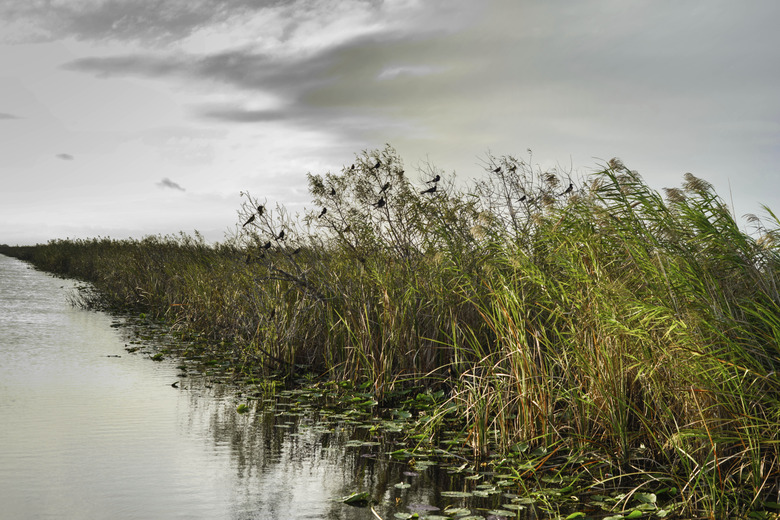What Is Sawgrass?
Despite the name, the wetland plants called sawgrasses, which belong to the genus Cladium, are not grasses at all but sedges. Sedges superficially resemble grasses with their slender, stalked growth and long, spear-shaped leaves. They differ, however, in that their stems are (usually) triangular in cross-section and solid, compared with the round, hollow stems of grasses.
Read more about the wetlands ecosystem.
Sawgrasses are quite widely distributed, from temperate regions of Eurasia and North America to the tropical Americas and Africa, and they form the signature look of the so-called "River of Grass": the huge Everglades marshland of South Florida.
Sawgrass Species
Sawgrass Species
Several sawgrass species make up Cladium, though the taxonomy (scientific classification) of the genus isn't completely agreed-upon. Smooth sawgrass or twigrush (also spelled twig rush; C. mariscoides) inhabits a broad range of central and eastern North America. Things get a bit more confusing with swamp sawgrass (C. mariscus), widespread in Eurasia.
Some taxonomists lump several other sawgrass types as subspecies of C. mariscus, while others separate them out as their own species: California sawgrass (C. californicus), native to the U.S. Southwest and Mexico; Jamaican swamp sawgrass (C. jamaicense), found from the southeastern U.S. through much of Central and South America and also in Africa; and leafy twigrush (C. intermedium) of Australasia.
General Description and Ecology
General Description and
Ecology
Besides its grasslike appearance, sawgrass is named for the sharp-toothed margin to its leaf blades: serrations made of silica that are capable of drawing blood from a bare arm or leg run across them. Initially established by seed, sawgrass spreads via underground stems, or rhizomes, which send up the aboveground flowering stems, or culms, and leaves.
The culms of some sawgrass species can reach 8 or 10 feet tall; coupled with the razor-edge leaves and dense, clumped growth, this can make sawgrass patches mighty intimidating to travel through.
Sawgrass is common in a variety of freshwater wetlands, growing along the edges of lakes, swamps and sloughs and also often dominating shallow or seasonally flooded marshes and fens. It's well adapted not only to withstand long periods of inundation but also drought and periodic fire.
Flames, for example, readily ignite the older dry leaves of Jamaican swamp sawgrass, but the growing, foliage-wrapped bud remains protected in the soil; the nutrients released in the marsh fire, meanwhile, trigger strong growth of new leaves for a quick recovery.
Jamaican Swamp Sawgrass in the Everglades
Jamaican Swamp Sawgrass in
the Everglades
Among the best-known sawgrass ecosystems in the world are the marshes of Jamaican swamp sawgrass in the Florida Everglades. This unique, climatically tropical wetland complex is fed by slow, relatively shallow "sheet-flow" drainage, and sawgrass dominates large portions of it that are covered for part or most of the year by a foot or so of water.
Read more about the types of trees in swamps.
These sawgrass marshes often border open-water sloughs and deeper marshes inhabited by maidencane, spike rush and other plants as well as drier marl prairies and wetter cypress domes.
While sawgrass remains extensive in the central and southern portions of the Everglades, it reached its zenith in the northern Everglades, where deep peat soils nurtured sawgrass stands that loomed 10 or more feet tall. Most of this part of the Everglades has been converted to sugarcane.
Ecology of Everglades Sawgrass Marshes
Ecology of Everglades
Sawgrass Marshes
Because they're so thoroughly dominated by sawgrass, sawgrass marshes aren't the most biologically diverse parts of the greater Everglades ecosystem. But they do foster plenty of life, including apple snails that lay eggs on sawgrass stalks just above the water level during the wet season as well as the snail kites that feed almost exclusively on those same snails.
Among the most fascinating features of Everglades sawgrass marshes are alligator holes. These are pools scattered within the marsh that gators excavate in peat or marl (calcite mud) that has accumulated in depressions in the underlying limestone bedrock, and which, being deeper than the surrounding sawgrass stands, hold water into the dry season.
Alligator holes thus attract fish, turtles, frogs and other aquatic organisms when water levels drop in the marsh, as well as birds, raccoons and other creatures that hunt and drink here – at the risk of occasionally providing lunch for the resident gator.
The deeper water and banked-up mud of a gator hole often allows willows to take route around it, forming a so-called "willow-head" amid the sawgrass flats.
References
- Florida Museum of Natural History: Sawgrass Marshes
- Flora of North America – Vol. 7; Flora of North America Editorial Committee, ed.
- Priceless Florida: Natural Ecosystems & Native Species; Ellie Whitney, et al. (eds.)
- The Everglades Handbook: Understanding the Ecosystem; Thomas E. Lodge
- Everglades Information Network & Digital Library: Shark Valley Guide
Cite This Article
MLA
Shaw, Ethan. "What Is Sawgrass?" sciencing.com, https://www.sciencing.com/sawgrass-5382252/. 30 July 2019.
APA
Shaw, Ethan. (2019, July 30). What Is Sawgrass?. sciencing.com. Retrieved from https://www.sciencing.com/sawgrass-5382252/
Chicago
Shaw, Ethan. What Is Sawgrass? last modified March 24, 2022. https://www.sciencing.com/sawgrass-5382252/
